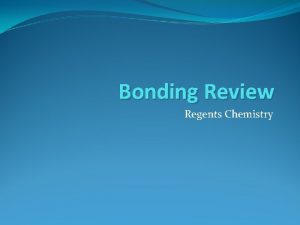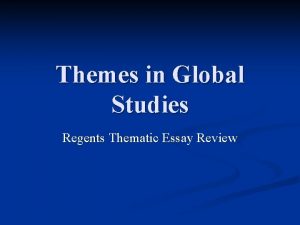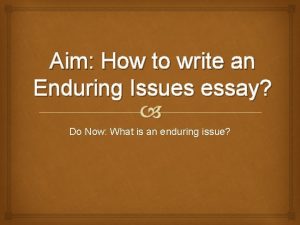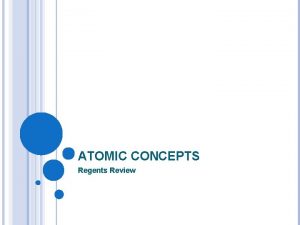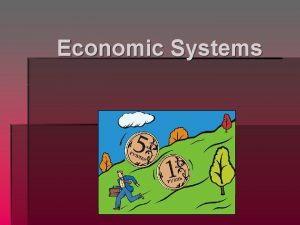Essay Review Economic Systems Components of the Regents











- Slides: 11

Essay Review Economic Systems!

Components of the Regents Essay • F – Facts, Evidence & Details (the explanation, specifics and substantiation of the essay) • O – Organization (Introduction, Body Paragraphs & Conclusion) • L – Level of Analysis (the long-range or immediate impact of the information on a society or on history) • D – Development of the Task (the bullets of the task)

The Economic Systems Essay! Task: Identify one society and one economic system that has been used or is being used in that society: • Discuss the historical circumstances surrounding the development of that system • Describe two features of the economic system • Evaluate the impact that economic system had on this society during a specific historical period

Economic Systems Traditional Market Command Mixed • Based on agriculture • Limited barter trade • Neolithic Civilizations • Early River Valley Civilizations • Based upon Supply and Demand • Usually focus on consumer goods • Little government control • Controlled by strong, centralized government • Usually focuses on industrial goods • Little attention paid to agriculture and consumer goods • Combination of Market and Command economic systems • Market forces control most consumer goods • Government directs industry in need areas.

Essential Information for this Essay!

Manorialism *Western Europe During the Middle Ages* • Circumstances: – Tribal invasions made Europe a dangerous place – Peasants & Lesser lords exchanged labor & loyalty for land & protection • Features: – Manor system is selfsufficient – limited trade or travel – Land is the basis of wealth and power • Impact: – Trade slowed – System of De-Centralized and confusing political loyalties emerged – Few people ever leave the manor on which they are born – Rigid social system based on birth

Capitalism *Western Europe In the Industrial Revolution* • Circumstances: • Features: – Governments had promoted small business during the era of mercantilism – Mechanizing inventions allowed development of factories & mass production • Impact: – Pure laissez-faire capitalism – no gov’t restrictions on business – Supply & demand pricing – Law of Competition (produces best products) – Abuse of labor. Long hours, low pay, terrible conditions, child labor. (No gov’t regulation) – Terrible living conditions (slums), environmental pollution – Ultimately standard of living rises as cost of products declines and wages increase (after gov’t involvement)

Communism *Soviet Union 1917 -1990* • Circumstance: – Social, Political & Economic conditions led to revolution – Bolsheviks institute a communist economy • Features: – Collectivized agriculture – Emphasis on heavy industry – Theoretical economic equality • Impact: – Lack of focus on consumer goods production led to low standard of living – Resistance to agricultural collectivization resulted in tremendous famine (20 million dead)

Mercantilism *Spain 1500 - 1820* • Circumstance: • Features: – Growth of commerce in Europe – Spain’s conquest of the Americas • Impact: – Amount of gold & silver in treasury defines the power of a nation – Nations seek to develop favorable balance of trade – Nations use colonies to assure favorable trade – Huge amounts of silver flood Spanish economy creating inflation (there and world-wide) – Spain closely controls colonial economies, focusing on mining and cash crop production; No colonial industry!

Mixed Economy (Socialist + Capitalist) • Circumstance: *India 1947 -1991* • Features: – Upon independence, India faced structural economic problems created by the partition of Pakistan – Needed to create industry • Impact: – Government ownership & control of major industries, transportation, communication & utilities – Private enterprise was encouraged at the local & retail level – Industry does develop, but economic growth is slow in the Nehru/Gandhi era (~3. 5% per year) – Budget deficits, inflation, food shortages – Rapid growth in 90 s & 2000 s as market economy is embraced

Communism *China 1949 -present* • Circumstance: • Features: – Anti-Nationalist sentiment led to revolution and a rise to power of the communist party • Impact: – Collectivized agriculture – 5 year plans focused on heavy industry – Introduction of capitalism under Deng Xiaoping – The Great Leap forward forced agricultural collectivization and focused on steel production. Tremendous famine – 30 million dead – Failure of the Great Leap led to the Cultural Revolution and greater disruption of China’s society – Deng’s changes have brought growth & prosperity (to some) in China
 Lesson 2 our economic choices
Lesson 2 our economic choices Us history regents review
Us history regents review Earth science practical review
Earth science practical review American history regents review
American history regents review Chemistry bonding regents questions
Chemistry bonding regents questions Thematic essay human rights
Thematic essay human rights Us history regents essay
Us history regents essay Whats an enduring issue
Whats an enduring issue Ccela
Ccela Enduring issues essay documents
Enduring issues essay documents Economic growth vs economic development
Economic growth vs economic development Difference between economic growth and economic development
Difference between economic growth and economic development




